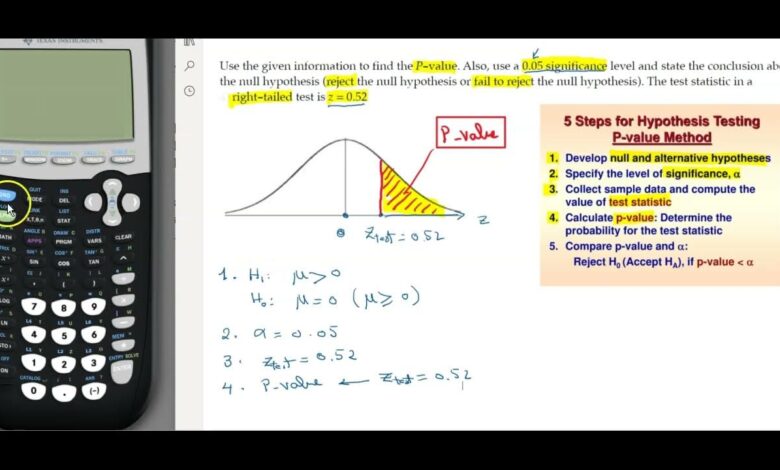Understanding the P Value Calculator: A Simple Guide

Welcome to our blog post about the p value calculator! This tool helps you find the p-value quickly and easily. Whether you’re a student or just curious about science, understanding p-values is important.
The p value calculator can help you know if your results are special or just happened by chance. In this post, we will explain what p-values are and how to use this calculator. We want to make learning about p-values fun and easy for everyone,
What is a P Value Calculator
A p value calculator is a tool that helps you find p-values for your data. P-values are important in science because they tell us if our results are special or just random. When scientists do experiments, they want to know if what they found is real. This calculator makes that easy!
Using this calculator is fun and simple. You just need to input your test statistics and choose the type of test you are doing. The calculator will then give you a p-value. This helps you understand if your results matter in your study.
Many people, especially students, use this tool. It saves time and helps them learn about statistics. You don’t need to be a math expert to use it!
How Does the P Value Calculator Work
The p value calculator works by using formulas from statistics. It takes numbers from your experiment and applies those formulas. First, you enter the test statistics, which are numbers that describe your data. Then, the calculator does the math for you.
Once the calculations are complete, it shows you the p-value. This number tells you how likely it is to get your results if nothing special is happening. If the p-value is low, it means your results are likely special and important!
Knowing how the calculator works can help you understand p-values better. When you learn to use it, you can make sense of the numbers you see in your experiments.
Why Are P Values Important in Science
P-values are very important in science because they help us make decisions. When scientists conduct tests, they want to know if their findings are meaningful. A low p-value suggests that the results are significant, meaning they are not just random luck.
In research, finding a low p-value can lead to new discoveries. It helps researchers understand if their hypothesis is correct. Scientists need p-values to support their ideas with evidence, and that’s why tools like the p value calculator are so useful!
Everyone from students to professionals relies on p-values to make informed choices. They guide scientists in knowing when to trust their findings and when to look further into their data.

Understanding One-Sided and Two-Sided P Values
There are two types of p-values: one-sided and two-sided. A one-sided p-value tests if a result is greater or less than a specific value. For example, if you want to see if a new medicine is better than an old one, you would use a one-sided test.
On the other hand, a two-sided p-value checks for any difference, whether it is greater or less. This means it looks for changes in both directions. This is often used when scientists are unsure about the outcome and want to be thorough.
Using a p value calculator can help you easily find both types of p-values. Just choose which test you need, and the calculator will do the rest!
Step-by-Step Guide to Using the P Value Calculator
Using a p value calculator is simple! First, gather your data and decide which test to use. You need to know if you are doing a t-test, chi-squared test, or another type. Each test has different rules.
Next, enter your test statistics into the calculator. This is usually a number that shows the outcome of your experiment. Then, click the button to calculate. In a few seconds, you will see the p-value.
After you get the result, you can check if it is low or high. A low p-value means your results are important. A high p-value suggests they might just be random. This guide helps you use the calculator easily!
Common Mistakes When Interpreting P Values
Many people make mistakes when looking at p-values. One common mistake is thinking that a low p-value means the results are perfect. A low p-value shows that results are not likely due to chance, but it doesn’t prove something is right.
Another mistake is ignoring the context of the data. P-values are just one part of understanding research. You also need to consider other factors, like sample size and study design.
Using the p value calculator correctly helps avoid these mistakes. Always remember to think critically about the p-value and what it means in your research.
Examples of P Values in Real-Life Experiments
Let’s look at some real-life examples of p-values. In a medical study, researchers might test a new drug. If the p-value is low, it means the drug works better than the old one. This can lead to better treatments for patients.
Another example is in education. Teachers might use a p-value to see if a new teaching method helps students learn better. A low p-value would suggest that the new method is more effective.
These examples show how important p-values are. They help researchers make discoveries that can change lives, and the p value calculator is a helpful tool in these studies.
When to Use the P Value Calculator
You should use a p value calculator whenever you conduct an experiment. If you are testing a new idea or treatment, this calculator can help you see if your results are significant. It’s useful in science, medicine, education, and many other fields.
Whenever you collect data, remember to analyze it! Using the calculator is quick and easy, so you can get answers fast. This is great for students who need to finish projects or researchers who want to publish their findings.
Knowing when to use the calculator helps you make the most of your data. It is a key tool in understanding your results!
Comparing P Values from Different Tests
When you have different tests, you might get various p-values. It’s important to compare these values to understand your data better. A higher p-value might suggest that one method is less effective than another.
Using the p value calculator allows you to easily compare results from different experiments. You can see which test gives you a lower p-value and decide which method is more promising.
Comparison is vital in research because it helps you see the bigger picture. Understanding the differences can lead to better conclusions about your data.
Frequently Asked Questions About P Values
Many people have questions about p-values. One common question is, “What does a p-value below 0.05 mean?” This usually indicates that the results are statistically significant. It suggests that there is a less than 5% chance the results are due to random chance.
Another question is, “Can a p-value be zero?” A p-value can be very small, but it cannot be exactly zero. It means the results are highly significant and unlikely to occur by chance.
Using a p value calculator can help answer these questions easily. It’s a handy tool for understanding statistics better!

Conclusion: Making Sense of P Values
In conclusion, understanding p-values is essential for anyone doing research. A p value calculator is a great tool that simplifies this process. It helps you find and interpret p-values quickly.
Learning about p-values can be exciting! They open doors to new discoveries and deeper understanding in science and other fields. With the right tools and knowledge, anyone can become skilled at using p-values in their studies.
Remember, p-values are just one part of research, but they play a vital role in making sense of your results. Happy calculating!
Conclusion
In summary, p-values are important tools in science that help us understand our results. When you use a p value calculator, you can find out if your findings are special or just random. This makes it easier for researchers, students, and anyone curious about science to make good decisions based on data.
Learning about p-values can be fun! They help us ask big questions and discover new things. Remember, using a p value calculator is simple and can guide you in your studies. So keep exploring, and happy learning.



